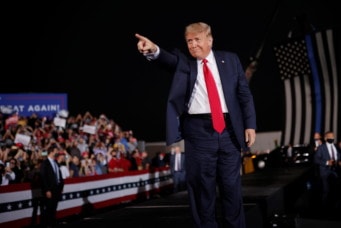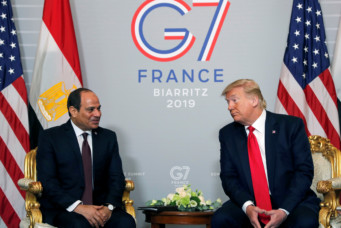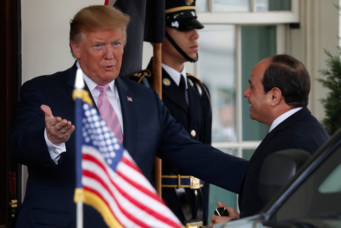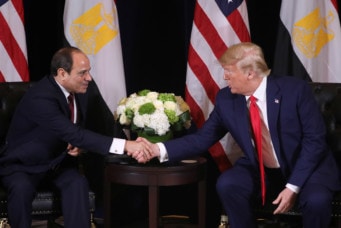OPEC+ versus the United States and World Democracies
The OPEC+ decision to cut oil production opens the door to further politicization of the global oil industry, particularly between the United States and Saudi Arabia
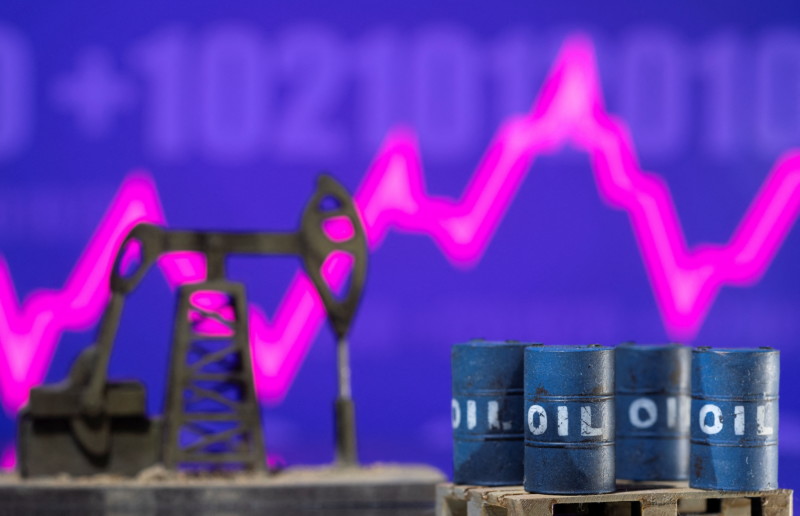
An illustration of oil barrels and a pump jack in front of a stock graph, Feb. 24, 2022. Dado Ruvic/Reuters
The OPEC+ decision on October 5, 2022 to cut production quotas by two million barrels per day has enraged Washington and widened the rift in relations between the United States and Saudi Arabia, which is widely considered the prime mover behind the decision. Despite the target set by OPEC+, this move, if implemented as announced, is expected to lead to a production decline of only about one million barrels per day. This is because not all members of OPEC+ would need to cut production at all since they are already incapable of producing enough to surpass the quotas allocated to them. However, the decision counts as objective support for the Russian Federation and its aggression against Ukraine.
As a result of its invasion, Russia faces sanctions on its oil exports imposed by the European Union (EU) and individual European countries. As sanctions set in in December, reduced production from other OPEC+ members will facilitate Russia’s task of finding alternative buyers for its oil. Furthermore, keeping prices high protects Russian oil revenue. The OPEC+ decision, therefore, puts an end to the pretense that the major Gulf oil exporters—namely Saudi Arabia, the United Arab Emirates (UAE), and Kuwait—maintain a position of neutrality and equidistance in the conflict between the Russian Federation and most Western democracies following the former’s aggression toward Ukraine.
The Gulf countries attempted to present the decision as being purely technical, motivated by the desire to stabilize the global oil market. Whatever the intention, one cannot fail to note that the move came after multiple requests on the part of the United States and major European countries to do exactly the opposite (that is, increase production and facilitate a decline in prices) to support the fight against inflation.
The U.S. and Saudi Arabia in 2022
It is an open secret that President Joe Biden is not a fan of the current Saudi leadership, and the reluctance he exhibited during his visit to the Kingdom in July 2022 was under global scrutiny. He accepted to go on that trip because his aides convinced him that Saudi Arabia would be amenable to increasing its oil production as needed in order to isolate Russia and make sanctions effective. It was immediately clear that the goal of the visit was not reached; in this light, the OPEC+ decision to cut rather than increase production cannot possibly be perceived by Washington as anything less than a hostile act.
It is worthy to recall that it was former president Donald Trump, not Biden, who in October 2018 said: “OPEC and OPEC nations are, as usual, ripping off the rest of the world, and I don’t like it. Nobody should like it…We defend many of these nations for nothing, and then they take advantage of us by giving us high oil prices. Not good.”
Thus, though Trump treated Saudi Arabia as a means of meeting security goals—maximizing weapons sales and protecting the financial interests of his relatives—it would be a mistake to expect that, if today not Biden but a Republican were in the White House, the U.S. reaction would be any different. Indeed, the official justification made for the OPEC+ decision is paradoxical. What is being claimed is that the decision to cut production is necessary in anticipation of a slowdown in demand due to the higher interest rates that central banks have adopted to fight inflation, the recessionary effects of the Russia-Ukraine war, and a possible slowdown in the Chinese economy. Of course, a cut in oil supplies and higher prices only enhance the risk of simultaneous inflation and recession, or “stagflation,” thus making the task of policymakers in industrial countries more difficult. Meanwhile, emerging economies—already struggling with the upward movement in import prices across the board and also facing higher prices for food and fertilizers that used to be imported from Ukraine or Russia—also have to deal with higher oil prices. Only the major oil exporters—who defend a level of oil rent that is needed for their large, if dubious, quality—and investment and sovereign wealth funds stand to gain in this situation.
It is true that the trend toward higher oil prices had already begun in 2021, months before the Russian invasion of Ukraine. And while this may be attributed to insufficient upstream investment on the part of oil companies, it is hardly by cutting production that more investment is encouraged. Higher prices have not been accompanied by significant increase in upstream investment either in OPEC or outside of it, and reducing quotas can only send the message that additional production is not needed. In fact, the move is based on the assumption that production from elsewhere in the world would not increase to compensate for OPEC+’s cuts, thus allowing a stabilization of prices at a higher level (it is said that the Saudi leadership is aiming for prices of around $100 per barrel). But past experience has demonstrated the opposite: when OPEC attempted to defend high prices in 1980–1985, and again in 2011–2014, production from outside OPEC (Alaska and the North Sea in the first case, U.S. shale oil in the second) eventually led to conflict within OPEC and abandonment of unrealistic price targets.
Short-Term Implications: U.S.–Saudi Relations
So, what may we expect with respect to future U.S.–Saudi relations? President Biden has publicly stated that there will be consequences for Saudi Arabia’s actions. At the time of writing, different scenarios are possible, and some developments may take place in parallel with each other rather than exclusively.
The first possibility is that the OPEC+ decision will in fact not be implemented. Faced with the strong reaction from Washington, the three concerned Gulf countries have taken action to repair the rift: for example, all three voted at the United Nations (UN) General Assembly in favor of the motion to condemn the annexation of four Ukrainian provinces by the Russian Federation. Then, Saudi Arabia promptly announced that it would extend $400 million in humanitarian aid to Ukraine. Finally, on October 25, the Saudi oil minister cryptically declared: “We will be the supplier of those who want us to supply,” which could mean that the kingdom is readying to supply any volume of oil necessitated by demand.
The second highly probable scenario is that the United States will use its Strategic Petroleum Reserve (SPR) as a tool to influence international oil prices. The SPR has already been tapped since March to inject one million barrels per day into the market over a period of six months, for a total of 180 million additional barrels. According to the Institute of Energy Research, the SPR is expected to shrink to a forty-year low by the end of October, with inventories of 358 million barrels, compared to 621 million barrels a year ago.
Following the OPEC decision, President Biden announced the release of a further fifteen million barrels. At the same time, the White House pledged to start buying back oil to replenish the reserve at a price of $67 to $72 per barrel. The move, Biden said, would “help create certainty around future demand for crude oil,” thus encouraging oil companies to invest in increasing production. Effectively, then, what is envisaged is the creation of a price corridor of $67 to $80 per barrel of crude oil produced in the United States. At the time of writing, U.S. West Texas Intermediate is trading between $85 and $90 per barrel; so, the goal of the U.S. administration is a further decline of some $10 per barrel.
Such use of the SPR has been criticized because, in theory, the reserve should be used only in case of emergencies and a physical shortage of oil. However, experience has repeatedly shown that oil is never physically scarce, because when supply is reduced prices increase rapidly and demand necessarily decreases. Ex post, the market is always in balance. Therefore, the national petroleum reserves that are maintained by all members of the International Energy Agency (IEA) have in fact rarely been used. In the current situation, a physical shortfall is rightly expected following the OPEC+ decision and the sanctions on Russian oil; hence, the envisaged use of the SPR seems perfectly justified. The determination of a price at which the SPR will start to be reconstituted serves the purpose of encouraging production in the United States and probably also in other regions outside OPEC+. In the past, OPEC’s market power has always been eroded by production increases outside of OPEC, and this may well be true again.
Another possible development is the imposition of a cap on prices for purchasing Russian oil. This measure is again favored by the U.S. administration, and the modalities for the enforcement of the cap are currently being discussed by the G7 group of major economies. Although the cap is only envisaged to affect Russian oil exports, it is clear that, if successful, it could be extended to imports from other producing countries, notably the major Gulf exporters. Indeed, this has been identified as one of the reasons behind the OPEC+ decision to cut quotas, which is viewed as a preventive measure against imposing a cap. What is shaping up is a battle for the control of oil prices, with the major industrial countries for the first time willing to directly interfere in the functioning of the oil market in a way that OPEC has done many times in the past.
A further possibility that has been discussed in the media is that the United States might react to the OPEC+ decision by curtailing weapons deliveries to Saudi Arabia. Major weapons contracts with the kingdom were signed under Trump, and President Biden has announced some further sales. Delaying delivery of some of the contracted weapons systems may remind Riyadh that it is very closely dependent on the United States for its security. However, one would expect that the delivery of weapons would instead be tied to making progress on some of the security-related disagreements, notably with respect to putting an end to the war in Yemen.
Instead, what may very well happen is that the “NOPEC” legislation initiative will be allowed to make progress in Congress. The No Oil Producing and Exporting Cartels (NOPEC) bill has been around since 1999, but successive administrations have shunned it in view of maintaining good relations with Saudi Arabia and other major oil exporters. The bill envisages modifying U.S. antitrust law to revoke the sovereign immunity that has protected OPEC+ members and their national oil companies from lawsuits. If signed into law, the U.S. attorney general would gain the option to sue the oil cartel or its members, notably Saudi Arabia, in federal court.
The OPEC+ decision to cut quotas has immediately revived the proposal, which passed in a Senate committee 17–4 in May, and now needs to pass the full Senate, the House of Representatives, and be signed by the president to become law. It is believed that NOPEC, if introduced to the Senate floor as planned, would likely get the sixty votes needed. The proposal is bipartisan and has strong support among both Republicans and Democrats.
If the bill passes, U.S. courts may impose substantial fines and threaten the seizure of assets owned by countries deemed to be participating in anticompetitive behavior. Although this may not be applicable to all OPEC countries, it is likely to affect not only the large industrial assets owned by Saudi ARAMCO in the United States, but also financial assets owned by the Public Investment Fund, Saudi Arabia’s sovereign wealth fund. It is also important to note that the lawsuit brought against Saudi Arabia by the families of the victims of the September 11, 2001 terrorist attacks remains open, and the Biden administration may lift the objections that have so far prevented the case from moving forward. From this discussion of potential alternatives available to the United States, we may easily conclude that the country has multiple and flexible tools to impose consequences on Saudi Arabia. Some observers believe that the Biden administration will refrain from using any of these tools, but the overwhelming impression is that the current Saudi leadership is not considered a reliable partner in Washington.
The OPEC+ cuts should become operational in November, and at the time of writing it is not clear what will actually happen. One will need to wait until the beginning of December and the start of the EU’s prohibition on importing Russian oil. In any case, politically speaking, the damage is done, and Saudi Arabia has lost the image of a reliable partner in the eyes of the U.S. and the EU: the eggs are broken and cannot be repaired, even if no omelet is made with them.
The Long-Term: the Viability of Oil
In the medium- and long-terms, the crucial question is: what will be the future role of oil as a source of energy? It is clear that recent developments have reinforced major industrial countries’ determination to drastically reduce their dependence on fossil fuels. It is also clear that the demand for oil will linger on for several decades, although the IEA in its latest World Energy Outlook expects that global demand will peak in 2035 at the latest. However, so far it has been assumed that the remaining demand will increasingly be satisfied by the lowest-cost producers that also have abundant reserves: i.e. by the members of OPEC. Hence, the IEA expects OPEC’s share (not OPEC+) of total crude oil production to increase from 35 percent in 2021 to 43 percent—and even 52 percent in one scenario—by 2050. But, is this a logical expectation?
For this vision to be credible, OPEC would need to behave competitively, and strive to maintain its oil exports in the face of declining demand, by offering low prices. If instead OPEC aims to target short-term revenue maximization by increasing prices, as their latest decision to lower production demonstrates, the rest of the world will inevitably react by investing elsewhere. This would not be the optimal solution; more important investment may be needed to increase non-OPEC production, while OPEC oil may in the end be left in the ground.
However, normal market response would bring this result about if oil prices remain at the level targeted by Saudi Arabia. Since 2014, the major international oil companies have curtailed investment first because of lower prices, then because of pressure to return value to investors and criticism from environmental, social, and corporate governance-conscious investors asking to stop investing in fossil fuels altogether. But with high prices, investment in new non-OPEC production remains extremely profitable and will attract both nimbler independents as well as international majors. What is needed on the part of the major industrial economies is a strategic decision to limit the market share of OPEC+ producers to make sure that prices are not unnecessarily jacked up.
Saudi Arabia claims that it is now just following the dictates of self-interest, but its future security and prosperity essentially depend on acceptance from the rest of the world. High oil prices may allow the kingdom to undertake flashy investment projects of dubious commercial viability, but run against the interests of just about every oil importer. If this strategy is not rapidly changed, the rest of the world will not accept it, and the Saudi state will face the consequences.
Giacomo Luciani teaches at the Paris School of International Affairs, Sciences Po, at the Graduate Institute of International and Development Studies in Geneva and at the University of Geneva. In 2010−13, he was Global Scholar at Princeton University. His work has focused on the political economy of MENA. With Hazem Beblawi, he edited the 1987 book The Rentier State, which is frequently cited as one of the origins of the concept. He is editor of the recently released Handbook of International Energy Economics.
Read More
